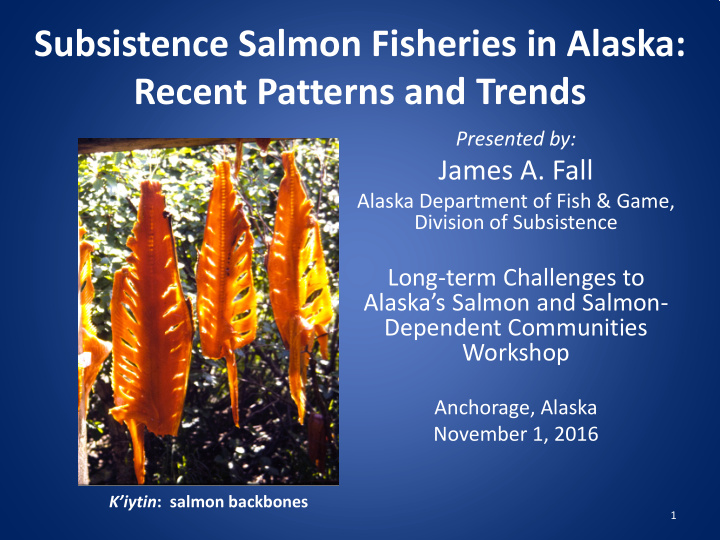



Subsistence Salmon Fisheries in Alaska: Recent Patterns and Trends Presented by: James A. Fall Alaska Department of Fish & Game, Division of Subsistence Long-term Challenges to Alaska’s Salmon and Salmon- Dependent Communities Workshop Anchorage, Alaska November 1, 2016 K’iytin : salmon backbones 1
Subsistence Salmon Fisheries: Supporting Cultural Traditions Nikolai, upper Kuskokwim River Fish camp, Yukon River near Eagle 2
Salmon: Bonding Families and Generations 3
Subsistence Salmon: Skills, Artistry, and Traditional Knowledge 4
Salmon: A Large Portion of Alaska’s Food Supply 5
6
Salmon’s Contribution: 96 lbs per person/year & 61% of protein requirements in rural Alaska; 25 lb person/year and 16% in Alaska overall 7
http://www.adfg.alaska.gov/sb/CSIS / 8
Salmon Harvest Assessment Methods • Permits • Post-season household surveys • Harvest calendars Tools of the trade 9
Alaska Subsistence Salmon Harvests, Composition by Species, Annual Average, 1994 - 2014 10
11
12
13
Yukon River and Kuskokwim River Chinook Salmon Chinook salmon harvest, Drifting for Yukon kings, Kuskokwim River 14 Kaltag
15
16
Data Gaps and Needs • In-season assessments by fishers • Post-season assessments by fishers • Timing and effort data • Patterns and trends analysis • TEK and LTK studies 17
Harvest Assessment: Best Practices • Joint ADF&G/AITC project: 2000 - 2003 • Working group • 10 regional workshops • Guiding principles and recommendations • Final reports available Salmon harvest assessment workshop, Kotzebue, November 2002 18
TEK: Traditional Ecological Knowledge; LTK: Local and Traditional Knowledge • Time depth • Local focus • Habitat • Timing • Abundance • Condition • Also: promotes collaboration 19
Some Conclusions About Alaska’s Subsistence Salmon Fisheries Salmon are a critical food throughout Alaska • Salmon sustain people, communities, and • cultures Five fisheries – Yukon, Kuskokwim, • Northwest, Bristol Bay, and Copper River – account for 88% of annual subsistence harvests Overall, subsistence salmon harvests have • been relatively stabl e since mid 1990s But, subsistence harvests are down since • 2008 in some key Chinook fisheries Gaps exist in annual assessments of • subsistence fisheries and in documentation of TEK/LTK There are opportunities to work together! • 20
Thank You! 21
Recommend
More recommend